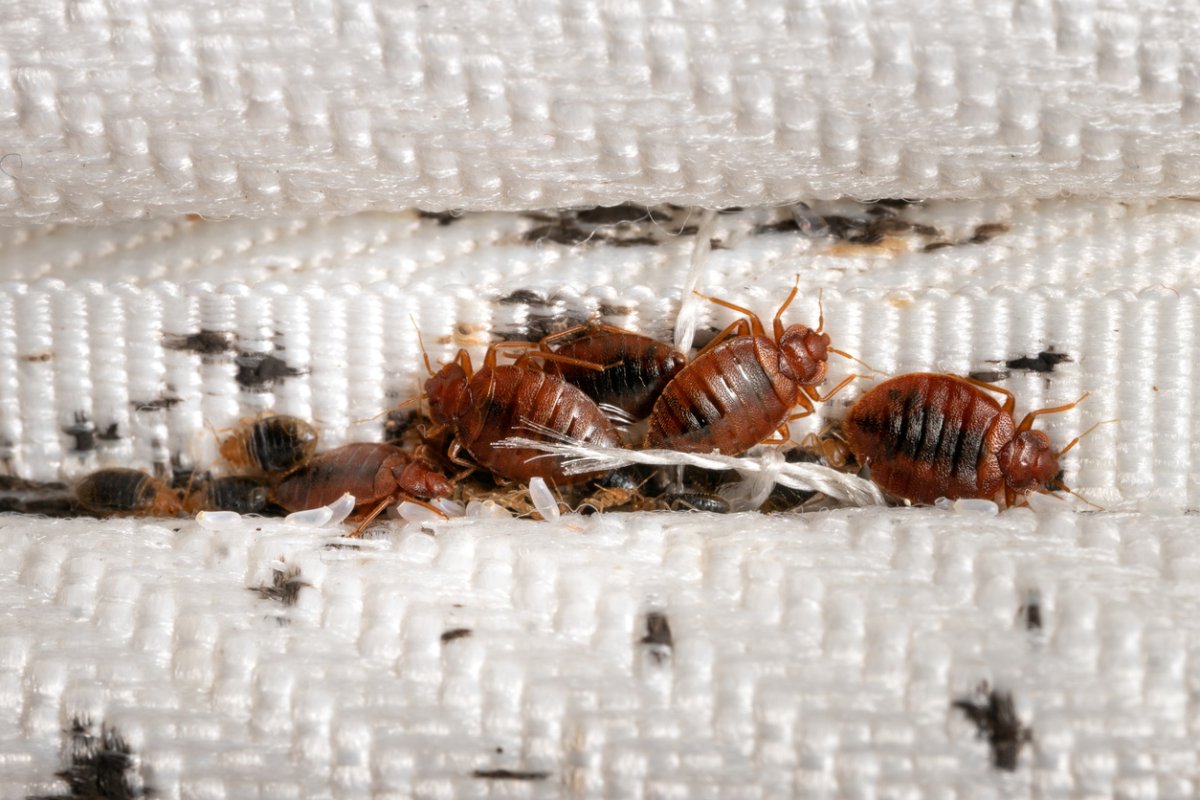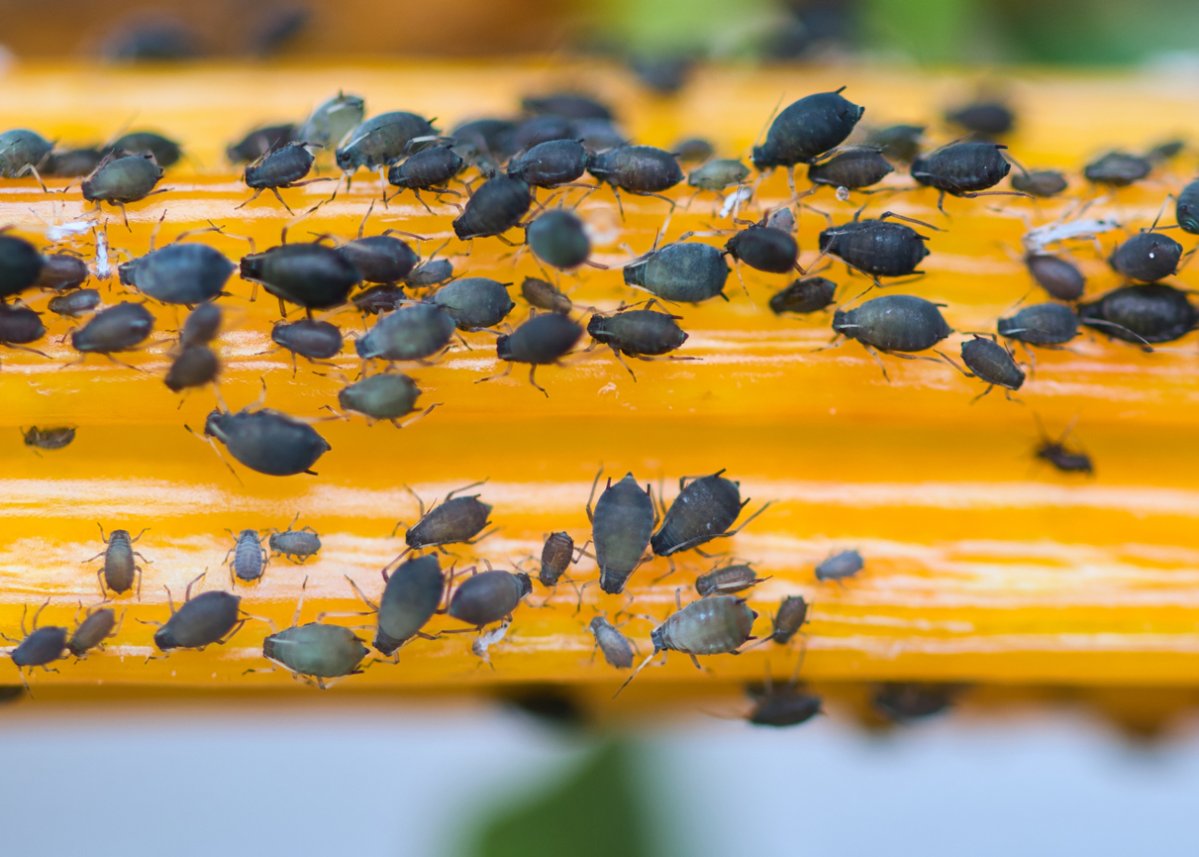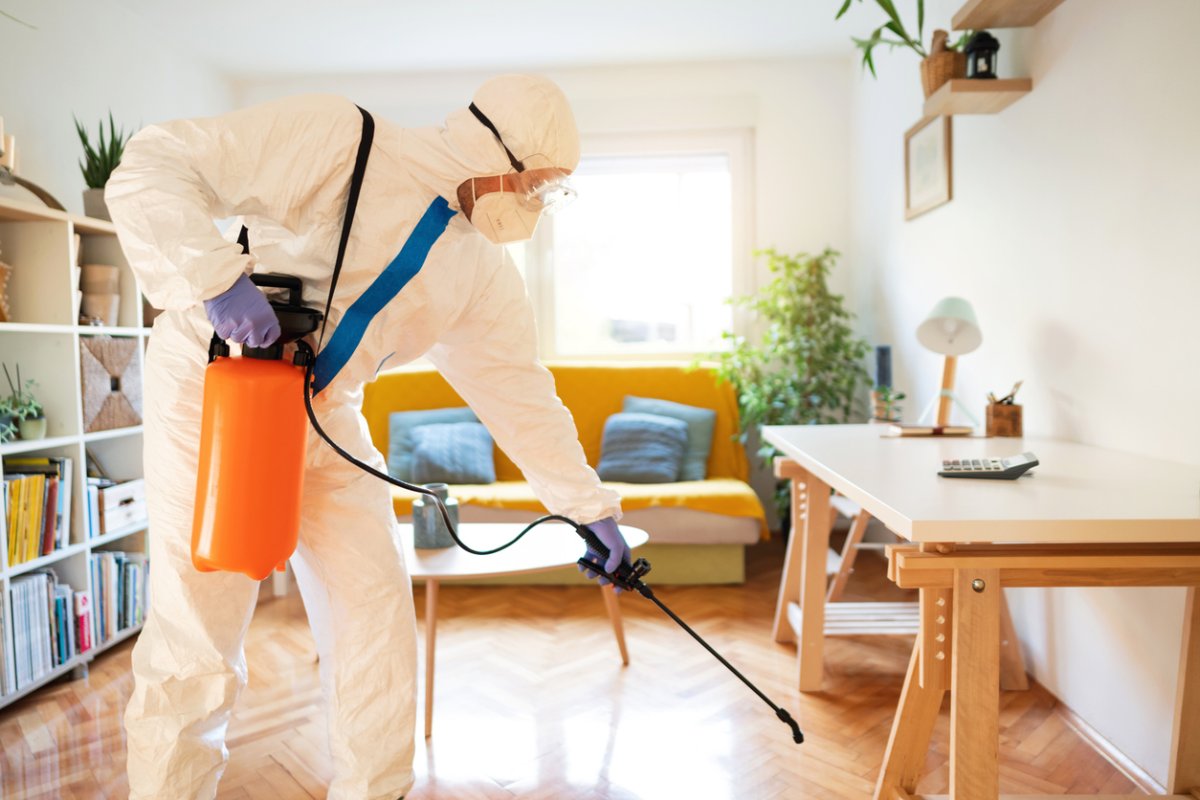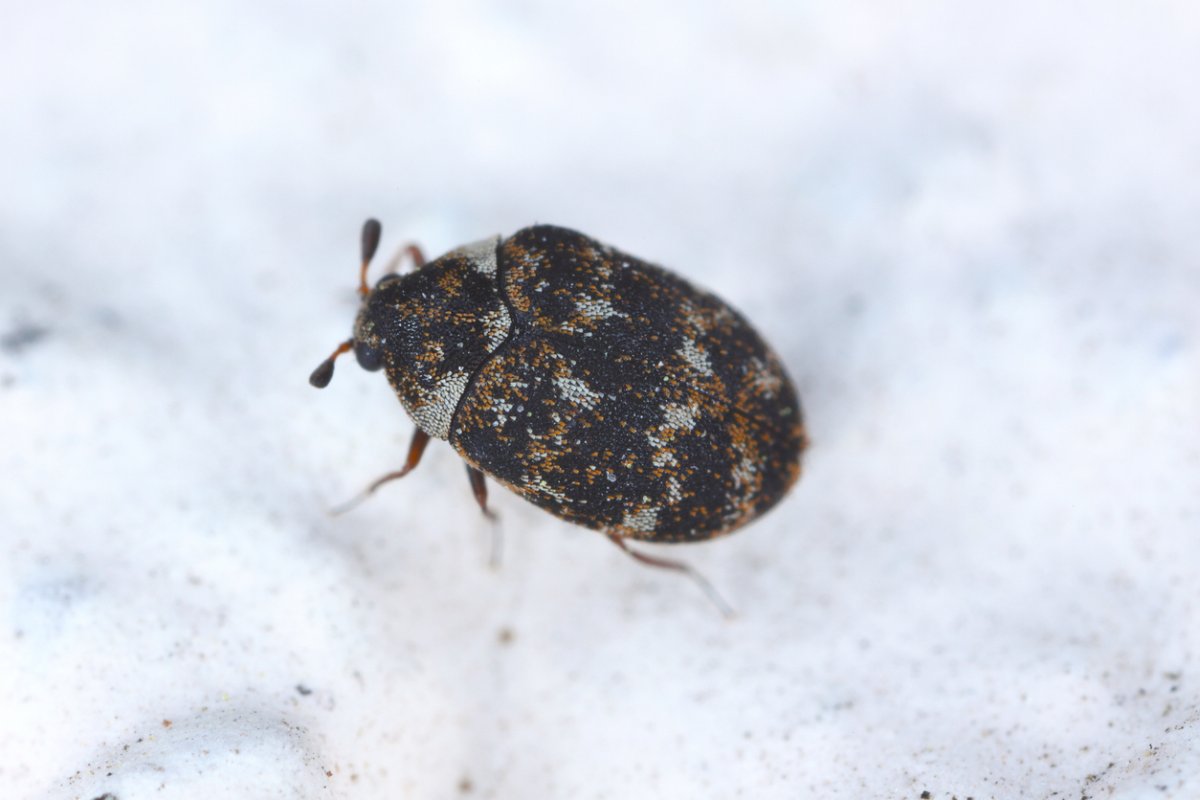We may earn revenue from the products available on this page and participate in affiliate programs. Learn More ›
What You Need to Know
-
- There are several different kinds of bugs that look like poppy seeds. Identifying the pest is the first step in eradicating a potential infestation.
-
- Some of the most common bugs that look like poppy seeds are ticks, bed bugs, carpet beetles, booklice, bird mites, black aphids, thrips, fleas, and flea beetles.
-
- Some black bugs that look like poppy seeds can be harmful to humans because of their potential to transmit disease. These include ticks, bed bugs, and fleas.
-
- When DIY methods fail, or if you don’t feel comfortable dealing with insects, it’s a good idea to let a pest control technician take care of insect infestations in the home.
Q: I’ve started noticing these tiny black bugs in my house that kind of look like poppy seeds. What are these black tiny bugs, and what should I do about them?
A: Some household pests are easy to spot and identify. For example, a cockroach scurrying across a kitchen floor is practically unmistakable. However, very small insects may not have many distinguishable features and could be harder to recognize. Tiny black bugs that look like poppy seeds could describe a host of household pests, from fleas to ticks to carpet beetles. Learning how to identify the most common potential pests and what attracts them will make it easier to remove these little black bugs from your home.
It may be necessary to collect some additional clues about these insects to identify them. For example, tiny black bugs in the house near the window could be flies or gnats making their way in from outside. But if the insects are found on furniture or in the carpet, they could be bed bugs or fleas. Take note of the appearance and behavior of the bugs to determine whether you can manage the problem with a bug zapper or need to get in touch with one of the best pest control companies (such as Orkin or Terminix).

9 Household Bugs That Resemble Poppy Seeds
Several tiny black bugs look like poppy seeds at a quick glance. Since pests are attracted to homes while seeking food, water, or shelter, the location of these pests and the type of food they seek can be a clue to their identity: For instance, tiny black bugs in bathroom sinks are likely to be a different type of insect than those found on home textiles or furniture.
According to Allan Bossel, operations expert at Bed Bug Exterminator (BBE), a Florida-based pest control company, “The common ones are fleas, carpet beetles, and bed bugs.” However, there are nine common bugs that could possibly fit this description.
Ticks are tiny black or brown parasites that look like poppy seeds, especially before feeding.
Before feeding, ticks are minuscule and flat, and they are easily mistaken for poppy seeds based on their dark brown or black appearance. They can also look like bed bugs at first glance because of their size and shape. These eight-legged parasites are prevalent in wooded or grassy areas where they cling to foliage and attach to any passing warm-blooded host, whether animal or human.
It’s most common to find ticks in the home after being outdoors. Protective clothing during outdoor activities can significantly mitigate the risk of tick bites, which can transmit illnesses like Lyme disease. It’s critical for household members to thoroughly check their clothing, pets, and skin for ticks so they can remove them as quickly as possible, ideally before they feed. Maintaining a trimmed yard and clearing leaf litter and debris frequently will also reduce the likelihood of having ticks on your property, and thus prevent them from entering the home.
Bed bugs are also parasitic and look similar to ticks at first glance. If you see one bed bug, you likely have an infestation.
Bed bugs are small, flat, and reddish-brown in color, resembling poppy seeds when they have not fed recently. After a blood meal, their bodies swell and become rounder in shape. According to Bossel, “Bed bugs might be the most concerning of these pests because they can hide in cracks and crevices around your bed and feed on your blood, leaving nasty bite marks.”
The spotting of even a single bed bug strongly indicates an existing infestation. Signs of bed bugs include rust-colored stains from crushed bugs or their droppings; small, pale-yellow skins shed by nymphs; and tiny, dark spots of their excrement. These parasites are often found within the creases of mattresses or in box springs and bed frames because they are attracted to the carbon dioxide and warmth humans emit. Bed bug treatment costs are not insignificant, but addressing the problem as soon as possible is key for preventing a widespread infestation. Hiring the best bed bug exterminators can ensure that all bed bugs and their eggs have been removed so that there is no danger of reinfestation.
Carpet beetles are dark and oval-shaped, and they’re primarily found on textiles. They can significantly damage clothing, furniture, and carpeting when left unaddressed.
Adult carpet beetles are typically small, oval-shaped bugs less than 1/4 inch long. They vary in color from brown to black or have a mottled combination of tan, white, and black, causing them to resemble tiny seeds.
“Carpet beetles are particularly drawn to natural fibers, so if you find them, check your carpets, clothing, and furniture,” Bossel advises. It’s a good idea to look out for shed skins and fecal pellets, as well as bare spots or irregular holes in textiles, as a sign of infestation. Common areas to check for activity include dark and secluded places such as closets, drawers, and underneath furniture where pet fur and dander might accumulate. Natural remedies such as vinegar or diatomaceous earth can be used to get rid of carpet beetles. However, if the problem persists, it may be necessary to hire a professional exterminator.

Booklice, or psocids, are only 1 to 2 millimeters long and may be white to dark gray in color. These insects feed on damp, starchy materials.
Booklice thrive in moist, humid environments and feed on the mold and starchy materials found in damp areas. It’s common to find these tiny black bugs in kitchen sinks or bathroom fixtures, or they might be spotted around leaky windows and plumbing.
Those who have a booklice infestation might spot the tiny bugs themselves or notice damage to paper products, books, or wallpaper where they might feed. Since booklice are particularly drawn to moldy or mildewed materials, any damp or decaying paper or cardboard is a potential hot spot for activity. Despite their name, however, these pests aren’t like typical lice and don’t pose a health threat to humans or pets. Addressing any moisture or humidity issues in the home is one of the best ways to get rid of booklice.
Bird mites are extremely tiny black bugs whose bites can cause itching and irritation.
Bird mites are among the tiniest black bugs, typically measuring about 1/32 of an inch long and generally a brownish or grayish color. Although their color may darken after feeding, these very tiny black bugs are characterized by their two main body parts and eight legs, which are observable under magnification. It’s typical to identify bird mites in warmer months upon seeing the mites physically or feeling a crawling sensation on the skin. However, according to the University of Minnesota Extension, bird mites cannot truly infest a home as they are not able to live and reproduce with only human blood as a food source.
Bird nests on or near a dwelling increase the likelihood of encountering bird mites. You may find these tiny bugs on windowsills where birds have recently nested. Preventive measures such as removing any nearby bird nests and ensuring that birds do not nest close to human habitats will reduce the chances of mites entering the home.
Black aphids are common garden pests that look like small dark seeds from a distance. They are notorious for damaging crops and plants.
Black aphids are typically less than 1/8 inch long and range in color from dark green to black. Although their soft, pear-shaped bodies are tiny, these pests like to gather in groups. Black aphids can be identified by their clusters on the undersides of leaves and stems.
Along with visibly damaging garden plants (which can be identified by curled or yellowed leaves and stunted growth), black aphids excrete a sticky substance known as honeydew. This substance can attract other insects and lead to the growth of sooty mold on plants. Not only does the mold look unsightly, but it can interfere with photosynthesis and harm a plant’s overall health.
Thrips as well as their droppings are small and dark, similar to poppy seeds.
Thrips are tiny insects that can be clear to black in color and resemble seeds that are only 1/20 of an inch long. These long skinny black bugs are distinctive for their dark excrement. It’s common to find these tiny black bugs on plants where they feed and leave visible holes. They leave behind white spots and black droppings that can be mistaken for poppy seeds.
Since thrips are notorious for being resistant to pesticides, putting out sticky traps or trying natural remedies like diatomaceous earth may be most effective for getting rid of these small black bugs.
Fleas are some of the smallest household insects and are black or gray in color. They often enter homes on animal hosts and can quickly turn into an infestation.
Fleas measure between 1/12 and 1/6 inches long and are known for their dark reddish-brown coloration and flat bodies. Thanks to their six long legs, fleas have no trouble jumping great distances. Bossel says, “Fleas are notorious for hitching rides on pets, so if you have one, inspect its bedding closely.” Those who find these tiny brown bugs in the house may also notice tiny, itchy red bumps grouped in clusters or lines on their skin, often around the ankles or legs. Pets may also show signs of discomfort by scratching excessively. Small black specks typically found in pet bedding, known as flea debris, are another indicator that a flea exterminator is needed. In many cases flea extermination costs are worth it since these pests are difficult to eradicate completely with DIY methods. Fleas can also carry diseases that are harmful to both humans and pets.
Not to be confused with fleas, flea beetles are small jumping insects that leave holes in garden plants.
Flea beetles are known for their ability to leap when disturbed thanks to their large hind legs. These very tiny bugs are black or metallic in color and often only 1/10 of an inch in size, which contributes to their seed-like appearance from a distance.
The presence of these tiny black beetles is most commonly identified by the characteristic “shot hole” damage they leave on garden plants. This type of damage often appears as small, round holes chewed through the leaves of a plant early in the growing season. Not only is the damage unsightly, it can also significantly impact the health of young plants, leading to reduced growth and potential crop loss.

When to Call a Pest Control Professional
If you have been unable to get rid of the tiny black bugs in your house, it’s time to call a professional exterminator. “When initial attempts like cleaning and using over-the-counter remedies fail to eliminate the insects, it’s best to ask for advice from an expert,” Bossel says. “Some persistent infestations need special treatments [that] are more effective than DIY methods.”
Pest control professionals can safely apply professional-grade treatments to the affected areas while minimizing harm to a home’s occupants and the environment. Professional help becomes especially important if the pests pose health concerns (such as bed bug bites or allergic reactions) or a risk of structural damage. “Neglecting these signals [of structural damage] can result in extensive and expensive repairs in the future,” says Bossel.
Most importantly, pest control pros can give customers targeted strategies to prevent future infestations, which saves time and future exterminator costs in the long run.


